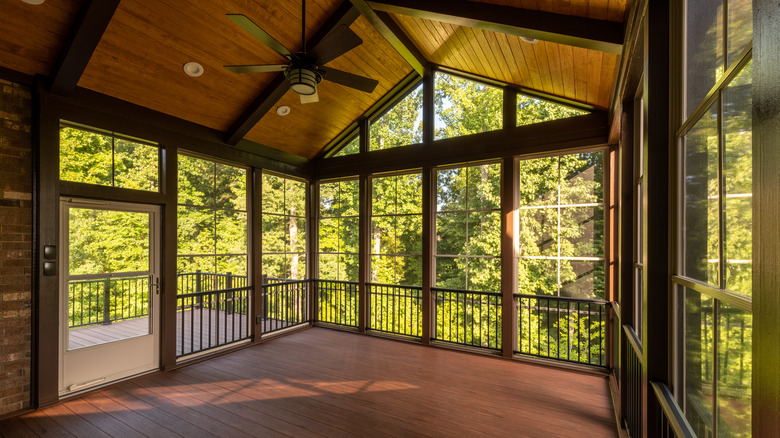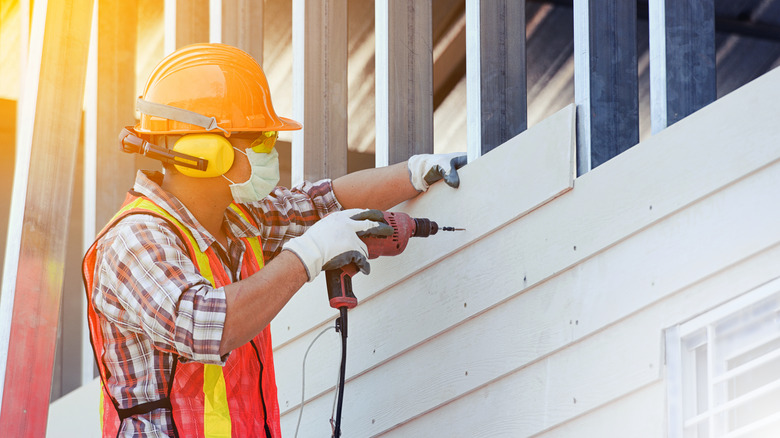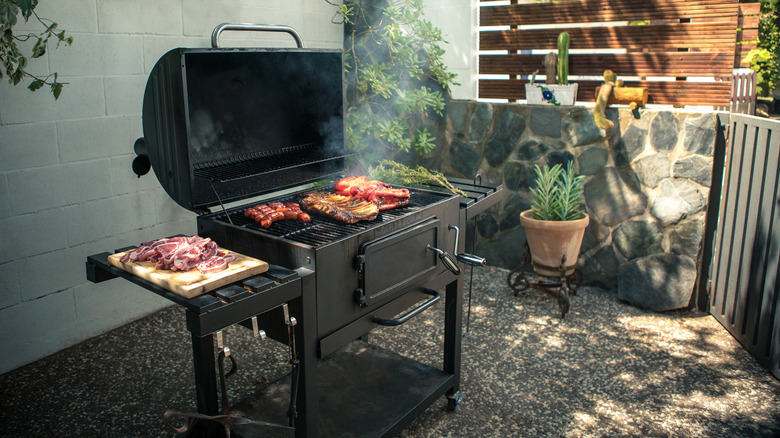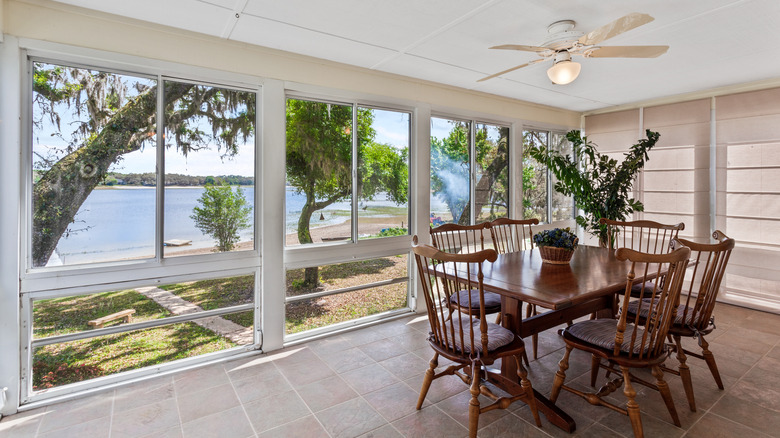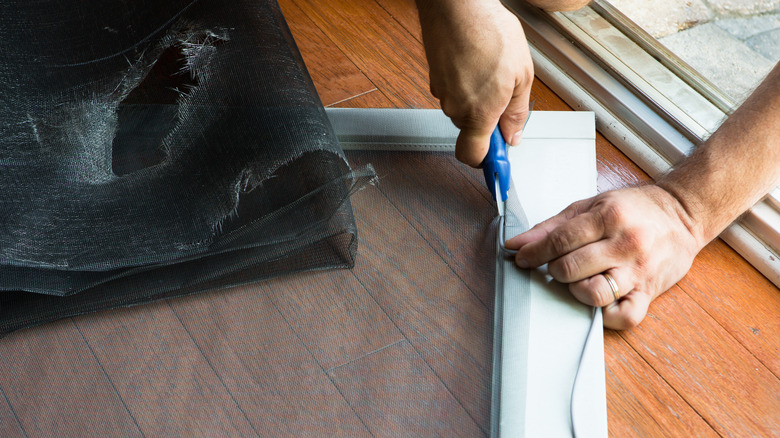How Much Does It Cost To Enclose A Porch?
Porches are a great way to extend your home's living space, whether reading on a relaxing afternoon or enjoying time with family and friends. Despite the fun and relaxation that an average porch provides, they do have limitations. Bright sunlight, rain, or too many mosquitos outside, can all spoil your continued enjoyment. There is, however, a way to change that. By enclosing the porch, you will be able to comfortably enjoy it around the clock, regardless of the weather or outdoor situation.
Home Advisor mentions that enclosing a 200-square-foot porch usually costs between $2,000 and $2,800 for the screens alone. You can add an extra $3,200 to $6,000 if you also want a roof or cover. These costs, however, can drastically change depending on the types of materials you decide to use. Home Depot states that of the three main types of screens you can choose from, fiberglass is the most popular screen chosen. This is not only due to the screen's relatively cheap price, but also its ability to be easily installed. If you're ready to take your porch to the next level with a comfortable enclosed area, this article will help break down the project for you, allowing you to comfortably extend your home in a way that fits your needs, wants, and budget.
Factors for cost
Enclosing your porch may not seem like a complicated task, but there are still many factors that need to be taken into account when trying to find the total cost. Some of these factors include the existing structure, location, size, materials, and labor, explains U.S. News & World Report. Let's take a closer look at these factors below.
Existing structure
Adding an enclosure around a porch that already exists is not a difficult process, and becomes even easier if you already have a roof cover. The cover could be from another porch above the area you want to enclose or a part of the roof over your house that extends over the area. It also decreases the total price of the project. When taking into account the structures that are already present, Home Advisor states that simply enclosing a covered area should not cost more the $5 to $7 per square foot, depending on the materials and the extent of a project.
Location
Although the location of your home may not seem to play a direct role in your project, it can still make a sizeable impact on the overall cost. Where you live often affects the number and availability of laborers who will be able to assist you with the project. This makes your options limited and possibly more expensive. If you need to order materials for your enclosed porch, the location of your home can also affect the delivery of those materials due to shipping options that may be limited for your area.
Other than direct location limitations, the government in your area may also have specific outlines and laws when it comes to adding structures to your home, such as local zoning and permit requirements. U.S. News & World Report states that depending on your local government, there may be specific requirements that need to be met when adding a roofed structure (including porches) to your home. Some requirements go as far as needing special approval from the government and signatures from expert architects and engineers that sign off on the plans, which, according to Home Advisor, can nearly add between $100 and $500 to the project.
Size and materials
Undoubtedly, the more space you wish to enclose the more the project is going to cost. Additionally, the type of materials you choose to use for enclosing your porch plays an even bigger role in the budget. Home Advisor states that there are three main types of screens. Foremost is the fiberglass screen, which is the cheapest and easiest to install. These screens usually cost between $4.50 and $5.50 per square foot. Aluminum screens are also a great choice that shouldn't cost more than $7 per square foot. For something more complex and luxurious, motorized screens are also available for a somewhat higher price of $2,000 to $4,000 per unit.
Labor
According to Home Advisor, the average labor cost for enclosing a porch is around $2 per square foot. Although this may not seem like a lot, for an average 200 square foot porch, labor alone would cost nearly $400. Home Advisor also mentions that, depending on the extent of your project, enclosing your porch can also be done fairly easily on your own. Although this could save you a good sum of money, there are still benefits that come with hiring a professional crew, including the project being completed in a timely manner, and built to your exact liking.
Additional Costs
You may also want to consider adding other elements to your enclosure to make it more comfortable for both you and your family. Extra items like steps, posts, railings, and even a door can range between $6,900 and $25,100 depending on the materials you choose.
Electricity
Nothing can make a space feel more comfortable than having electricity. Electricity can bring a variety of comforts to your outdoor area, including lighting, television entertainment, and heating or cooling. According to U.S. News & World Report, you can expect to spend between $4,000 and $6,000, depending on how many electrical items you wish to use on your porch.
A fireplace
If you want to give the space elements of warmth and coziness, a fireplace can also be added to an enclosed porch. Fireplaces not only elevate the area, making it look more comfortable, but they can also heat the area. U.S. News & World Report states that the average cost of installing a heater is $3,000. This, however, does not include the installation cost, which will vary depending on if it uses electricity or gas.
Outdoor kitchen
The addition of an outdoor kitchen allows you to prepare and enjoy meals outside. The extent of your outdoor kitchen can vary depending on your desires and budget. Simply adding a grill can cost anywhere between $200 and $4,000, according to Landscaping Network, whereas a complete kitchen set-up can cost significantly more.
Types of enclosed porches
When it comes to enclosing your porch, there are two main types of structures you can choose from. Patio Enclosures states that these types are called screen rooms and three-season rooms.
Screen room
Creating a screen room is the simplest, cheapest, and most popular way to enclose your porch. This type of enclosure allows you to easily enjoy some fresh air from behind the comfort of your screens, which keeps poor weather, bugs, and a variety of garden debris outside of the area. Because this area is still somewhat exposed, Patio Enclosures states that heating and cooling systems are ineffective. A fan could be placed in this area along with an electric heater to slightly cool and heat the area, but air conditioning or a modern heating system would be pointless to install.
Three-season room
Offering more protection than a simple screened room, a three-season sunroom is a porch that is sealed with floor-to-ceiling glass windows instead mesh screens. This separates the area from the outside environment while still allowing users to enjoy the view. This type of enclosure acts as an extension of your home as it can be temperature-controlled and enjoyed just as you would enjoy any other room in your house, notes Screen Mobile. Keep in mind, however, that a three-season room takes away nearly all outdoor aspects of your porch, except for the view. This means that you will have to open a window or go outside to enjoy some fresh air.
Maintaining your enclosed porch
Just as important as the building and installation process, maintaining your enclosed porch is also essential. Quality Screen mentions that a screened-in porch can last nearly eight years when properly maintained. Let's take a look at some ways to keep your enclosed porch well-maintained and lasting far past this basic period of time.
Clean the area regularly
The first step to keeping your enclosed porch maintained involves cleaning the area regularly. Decks Direct mentions that to clean the area you should start by sweeping, vacuuming, or blowing out unwanted debris, then, thoroughly mop the area to remove any dust, dirt, or pollen. Always check for spiderwebs and any other insects that may have slipped through the cracks of your screens and sweep them away, too. Additionally, Quality Screen suggests that tiled floors should be mopped regularly and wooden floors need to be sealed, as well. If you do not seal your wooden floor, your floor will become dry and cracked.
Clean the screens regularly
After a while dirt, pollen, and a variety of other debris can start to build up on your screens, therefore, they must also be cleaned regularly. This not only improves the quality and lifespan of your screens but also clears the area of common allergens. To clean the screens, Decks Direct suggests removing them from their frames and using warm water and an all-purpose cleaner to gently scrub the mesh. After scrubbing, you should thoroughly rinse the screens with a garden hose and allow them to air-dry before placing them back in their frames.
Routine maintenance
Because your enclosed porch is an outdoor living space, you can expect some amount of wear and tear. Although occasional damage can not be prevented, routine maintenance can stop it from getting worse. This means that, according to Quality Screen, if a rip or tear occurs in your screens, you should patch it up immediately to avoid further damage to the screen or interior parts of the enclosure. Similarly, screen doors should be kept well-greased to avoid damage and unwanted noise.
Find a professional
If you are worried about unseen damage or improper installation, it may be a good idea to call in professional help. Quality Screen mentions that although hiring a professional costs money, they will ultimately ensure your enclosed porch looks better, lasts longer, and avoids any damages before they start.
Benefits of an enclosed porch
Although enclosing your porch may feel a bit contradictory, it comes with a variety of benefits for both you and your family. Let's take a look at some of these benefits below.
Enjoyed through any weather
Gehman states that one of the best things about having an enclosed porch is being able to enjoy it regardless of the weather outside; you can sit and read amongst the spring rain without getting wet or simply relax in the nice warm weather without being bothered by the sun. Depending on the extent of your enclosed porch, you can even comfortably sit outside in the hot summer or freezing winter with a fan or heater installation.
Insect protection
Sitting outside in nature is supposed to be a calm and relaxing experience, but sometimes it can be disrupted by pesky insects, like mosquitos, bees, or spiders. Enclosed porches, however, keep those insects at bay, allowing you to relax and enjoy nature without their annoying presence, notes Gehman.
Multi-functional space
Pressure Point Roofing mentions that another great thing about enclosed porches is that they are useful for a variety of events, whether it is meant to take place outside or not. You can add a unique outdoor touch to any situation by utilizing your protected outdoor living space. For example, you can allow children to safely play in this area or host a barbeque without worrying about a rain shower.
Add value to your home
Above all, an enclosed porch is also a great way to add value to your home, especially if you are considering selling your home anytime soon. In today's competitive real estate market, you may be looking for ways to make your home both worth more and more attractive to buyers. Carolina Home Exteriors states that house hunters see enclosed porches as an extra area of living space, which can go a long way for both the attractiveness of your home and the amount you will receive.
